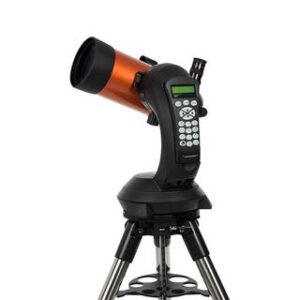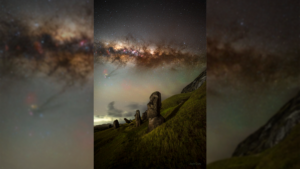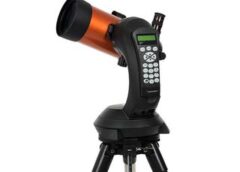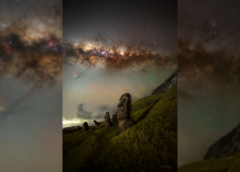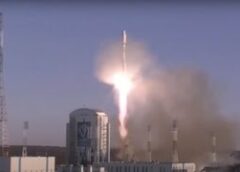If spacecraft are to visit the outer solar system, they must cross the asteroid belt between Mars and Jupiter. The Pioneer mission was faced with the question of just how dangerous this asteroid belt would be to a spacecraft passing through it.
Read MoreCosmonauts dock Russian Progress cargo ship to ISS on remote control after autopilot glitch
Russian cosmonauts on the International Space Station (ISS) took manual control of an incoming cargo ship carrying tons of supplies after its automated rendezvous system suffered a glitch. The unpiloted cargo ship, called Progress 86, docked to the station’s Russian-built Poisk module under remote control by Roscosmos cosmonauts Oleg Kononenko and Nikolai Chub, who tracked its approach from inside the ISS. Kononenko took control of the cargo ship remotely using a system called TORU, while the Progress 86 craft was flying around the station at a range of about 150…
Read MoreA ‘runaway star’ could save Earth from extinction a billion years from now. Here’s how.
About a billion years from now, the sun will have become much bigger, brighter and hotter, likely leaving Earth uninhabitable. However, a chance encounter with a passing star could save our planet by tossing it into a cooler orbit or helping it break free of the solar system entirely, a new theoretical study suggests. (Still, the chances of that happening are extremely slim.) Today, Earth lies within the sun’s habitable zone, a ring-shaped region within which planets may harbor liquid water. But our planet’s situation will worsen as the sun…
Read MoreChina’s Landspace gears up for 3rd launch of its methane-powered rocket
Chinese launch startup Landspace is set to launch its methane-powered rocket early next month. This time, the Zhuque 2 (Vermillion Bird 2) rocket will be carrying satellites and aims to demonstrate its operational launch capabilities. The launch comes just under a year after its first Zhuque-2 launch which ended in failure. It bounced back with its second launch in July, successfully reaching orbit. That launch however carried only a mass simulator rather than active payloads. Related: China launches mystery satellite on Long March 7A rocket (photo) The 162 ft (49.5…
Read MoreThis Week In Space podcast: Episode 89 — Who’s in Charge in Space?
On Episode 89 of This Week In Space, Tariq and Rod discuss the challenges of regulating spaceflight. With an increase in commercial and private spaceflight comes the need to regulate it, and the FAA has had a major role in newspace flight rules to date… but should it be the primary regulator moving ahead? Many in the field say no, and some decry most attempts at what they see as unnecessary control. We at TWiS feel that, like any other form of transportation, proper and healthy regulation is needed–the question…
Read MoreUnwrapping Uranus and its icy secrets: What NASA would learn from a mission to a wild world
Uranus, the seventh planet from the Sun, orbits in the outer solar system, about two billion miles (3.2 billion kilometers) from Earth. It is an enormous world – quadruple the diameter of Earth, with 15 times the mass and 63 times the volume. Unvisited by spacecraft for more than 35 years, Uranus inhabits one of the least explored regions of our solar system. Although scientists have learned some things about it from telescopic observations and theoretical work since the Voyager 2 flyby in 1986, the planet remains an enigma. It’s…
Read MoreLockheed Martin’s ‘Tantrum’ tech could help get satellites up and running without the wait
Lockheed Martin and Firefly Aerospace are combining to launch a demonstrator that aims to slash the time it takes spacecraft payloads to become operational. The unique wideband Electronically Steerable Antenna (ESA) developed by Lockheed Martin will test rapid calibration and could pave the way to payloads becoming operational much quicker. Calibration is the process of fine-tuning the sensor system to ensure it operates accurately and effectively once it is in orbit. While it can take months for traditional on-orbit sensors to be powered on, fully calibrated and readied to perform…
Read MoreHow to watch ‘Doctor Who’ anniversary specials: Stream ‘Wild Blue Yonder’ from anywhere
‘Doctor Who: Wild Blue Yonder’: Key information • Airs at 6:30pm (GMT), 1:30pm (ET) and 10:30am (PT) on Saturday, December 2• UK: Watch for FREE on BBC One and BBC iPlayer• Away from home: Use a VPN such as ExpressVPN to watch your usual service from anywhere• US, Canada and Australia: Disney Plus has the rights to stream “Doctor Who: Wild Blue Yonder” internationally The Doctor is back! To mark the 60th anniversary of the UK’s biggest sci-fi export, David Tennant returned to the TARDIS last weekend, alongside Catherine Tate as companion Donna…
Read MoreNASA’s Artemis 3 astronaut moon landing unlikely before 2027, GAO report finds
The Artemis 3 mission, which is now tentatively scheduled to fly in December 2025, may have to wait until at least 2027. NASA’s endeavor to return humans to the moon for the first time since the Apollo program with the Artemis 3 mission will likely be delayed because it is jeopardized by “multiple challenges” and an ambitious schedule, the U.S. Government Accountability Office announced Thursday (Nov. 30). Based on interviews with NASA and industry officials and reviewing documentation, the GAO reported it found a significant amount of pending technical work…
Read MoreNASA Welcomes Angola as Newest Artemis Accords Signatory
NASA During a ceremony in Washington Nov. 30, Angola became the 33rd country to sign the Artemis Accords. The Artemis Accords establish a practical set of principles to guide space exploration cooperation among nations, including those participating in NASA’s Artemis program. NASA, in coordination with the U.S. Department of State, established the Artemis Accords in 2020 together with seven other original signatories. Since then, the Accords signatories have held focused discussions on how best to implement the Artemis Accords principles. The Artemis Accords reinforce and implement key obligations in the…
Read More